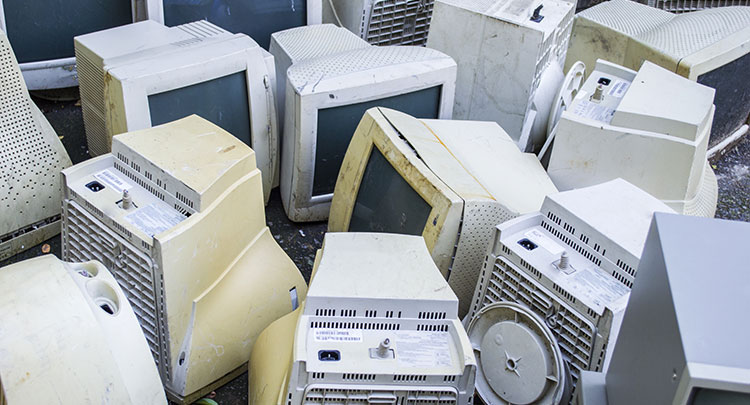In a recent letter to WEEE handling organisations, the Environment Agency has provided additional guidance to ensure they comply with the legal requirements for POPs and hazardous waste.
Following on from advice issued a year ago focusing on display devices, small mixed WEEE and plastic containing wastes arising from their treatment, this new letter provides additional advice on all other categories of WEEE and the various components and parts removed from WEEE.
The letter explains that the Industry Council for Electronic Equipment Recycling (ICER) has worked in cooperation with Defra and the Environment Agency to publish an investigation into the presence of Persistent Organic Pollutants (POPs) in a range of WEEE. Government guidance has now been updated in light of this report.
The EA make clear in the letter that as an organisation handling WEEE “You have a statutory Duty of Care that applies to waste you produce, transport, receive, treat, broker or deal. Your responsibility does not end when you transfer the waste to someone else. You should make sure that the person you transfer the waste to will manage it appropriately.”
The EA will focus on businesses mis-describing hazardous and POPs waste, which leads to it being subsequently mismanaged or exported without notification. They go on to warn that “Where we identify non-compliance we will work with operators to bring them into compliance and where necessary take enforcement action.”
Classification of WEEE
The EA state that wastes must be correctly classified and described, making the presence of hazardous chemicals and persistent organic pollutants clear in the waste description. To enable this classification the law states that the organisation must undertake an assessment of the chemicals present.
The ICER report has clarified that some large domestic appliances (washing machines, tumble dryers, dishwashers and cookers) are non-hazardous and non-POPs waste. Meanwhile fridges, freezers, chillers and air-conditioning units are considered hazardous but non-POPs.
Importantly small mixed WEEE, display devices and ‘Category 1-7 devices (other than LDA white goods) of a household type, from household or business sources’ are all described as being hazardous and POPs waste.
It must also be noted that all other devices must be treated as precautionary hazardous and POPs waste until the chemistry of circuit boards, plastics and cables is determined and assessed.
Regarding the management of wastes containing POPs, the EA states that “The POPs present in the plastics, cables and printed circuit boards of WEEE that is POPs waste must be destroyed (or irreversibly transformed) by subsequent waste management activities. You are not allowed to recycle or reuse these POP containing materials or components.”
Reuse of WEEE as EEE
Regarding the reuse of WEEE, the EA advise “Electrical devices containing POPs can be re-used provided that they are not, and were never previously, waste. As such, this reuse can never generate evidence of recycling or recovery for the purposes of the WEEE Regulations. However if, at any point, an electrical device containing POPs becomes waste, it becomes subject to the legal requirement to destroy (or irreversibly transform) the POP. You are not allowed to reuse this device and it cannot cease to be waste, even if it is in working order. The POPs must be destroyed.”
“Organisations wishing to re-use WEEE would, in addition to other requirements, need to implement effective and reliable techniques to identify which devices contain POPs in plastic components, cable and printed circuit boards to enable them to distinguish and separate out those devices that contain POPs (and require destruction) from those that don’t. The latter can be reused or recycled.”
Other areas of updated guidance cover the classification and treatment of components removed from WEEE, wastes from WEEE treatment and hazardous waste controls and the exporting of WEEE, treated WEEE and used EEE.
Sue Nolan, procurement manager at Ecosurety commented "It is important that POPs are handled responsibly and irreversibly transformed within the waste stream - it is the time for our generation to do the 'right thing'. The biggest regret is the ramifications this brings for reuse of WEEE."
Download the Waste Electrical and Electronic Equipment (WEEE) – August 2020 update.
Temporary CRT glass update

In a separate update, the EA is now temporarily allowing CRT glass from old displays to be sent to landfill. CRT glass is typically blended with concrete and used for things like barriers, however, the EA end of waste panel recently decided that this method can no longer be classed as 'end of waste'. There were concerns that this would affect the uses for the CRT concrete blocks and could reduce demand, therefore preventing AATFs from being able to move the material on. The EA and Defra were called on to provide a solution to prevent the build-up of CRT glass at designated collection facilities.
The EA has now made the decision to allow CRT glass to be send to landfill without it having an affect on obligations to meet recycling targets. This exception will expire on 1 November 2020. During this period, treatment facilities must put measures in place so that the glass can treated appropriately and a market can be found in order to meet recycling targets.
If you would like to discuss how any of the above may affect you as a producer or recycler, please contact our team.

Ben Luger
Marketing projects specialist
Ben joined the team at the beginning of 2015 and helps drive marketing communications and projects for Ecosurety, including project managing the launch of the Ecosurety Exploration Fund and website content development.

Latest News

Q2 2024 recycling data shows strong performance in H1
By Sam Marshall 24 Jul 2024
Ecosurety continue to step up for refill and reuse
By Victoria Baker 24 Jun 2024
Ecosurety renews B Corp™ certification with flying colours
By Louise Shellard 11 Jun 2024
Ecosurety sponsor the 2024 Carbon Literate Organisation Awards
By Louise Shellard 07 Jun 2024
